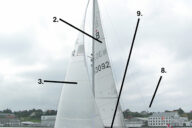Captain John of skippertips.com has a important reminder about navigating safely around container ships.
This ship’s freeboard (distance from deck to waterline) combined with her stacked containers creates a substantial blind spot ahead of the bow. And you could get caught inside this blind spot without realizing. Inside this area, you will become invisible to both visual and radar scanning.
Look straight up at the bow of a large ship moored inside any harbor in the world. Freeboard–or the distance from the bow (or deck) to the water surface–can be dozens of feet. Matter of fact, the distance from the water to the deck of some Navy aircraft carriers will be 60 feet or more!
Beam Aboard and Assume the Watch!
Now, let’s do something different. Remember those old Star Trek movies? Imagine that you beam yourself up to the bridge (control center) of one of these sea monsters. Put yourself into a deck officer’s uniform and assume the watch at sea. Look at the illustration below and note how the bow blocks part of your visibility.

Note how far this ship’s superstructure lies aft of the bow. Cargo ships are often built like this for cargo or freight storage. Deck watch officers stand their watches on the aft bridge, high up off the deck. The bow can block their view of vessels nearby (yellow shaded area).
You will be unable to see any objects inside the “blind spot” area (yellow sector) forward of the bow. On ships with extreme freeboard, this can be several hundred yards. The small sailboat crossing the bow would never be seen. And in the event of a collision, the impact might not be felt or heard!
Play Defense to Stay Safe and Alive!
 In past newsletters, we have written about the importance of drift bearings and rate of drift. When you first sight a target, obtain a bearing. Use a handbearing compass or swing the bow of your boat toward the vessel and take a magnetic bearing.
In past newsletters, we have written about the importance of drift bearings and rate of drift. When you first sight a target, obtain a bearing. Use a handbearing compass or swing the bow of your boat toward the vessel and take a magnetic bearing.Write the bearing down. Note the location on the ship where you shot the bearing (bow, beam, mast, superstructure, stern). Wait two to three minutes and take a second bearing to the same object. Shoot a third bearing with your compass two to three minutes later. Compare all bearings.
You want a separation of at least 3 degrees between bearings. And, you want all bearings to increase or decrease in succession. Bearings that look like this: 010°, 014°, 017° are increasing to the right, called “right bearing drift”. Bearings that look like this: 128°, 124°, 120° are decreasing to the left, called “left bearing drift”.
If you note a slower rate of drift (less than three degrees of separation) or no change in bearings at all, this indicates a great risk of collision. Shoot another bearing for verification if you have the time. If you still show little to no change, take action to avoid a collision. You could change course, change speed, slow down or stop. Avoid small changes in course or speed. Make your actions apparent to the other vessel to avoid confusion.
Remember that small cruising sailboats sail at average speeds of just 4-6 knots. You will need lots of time to maneuver against a 20 to 30-knot freighter or tanker. A 20-knot freighter covers one nautical mile in just 3 minutes. A 30-knot freighter covers one nautical mile just 2 minutes. Take action early and make any course or speed change substantial!












